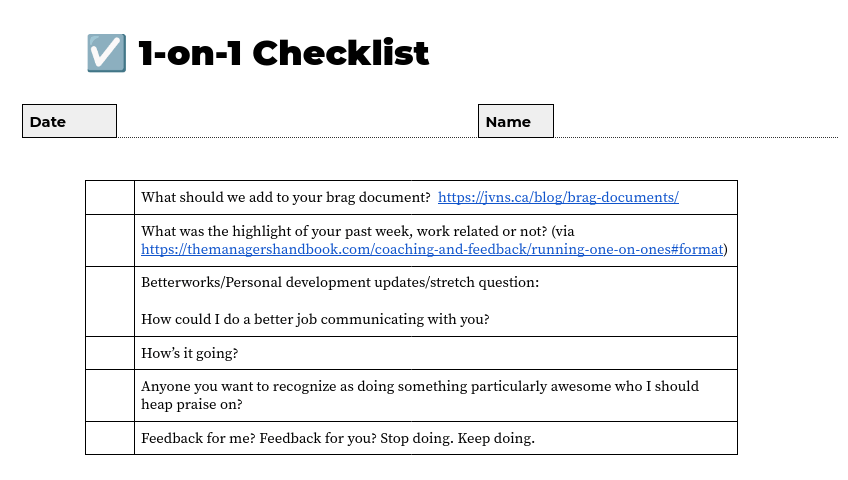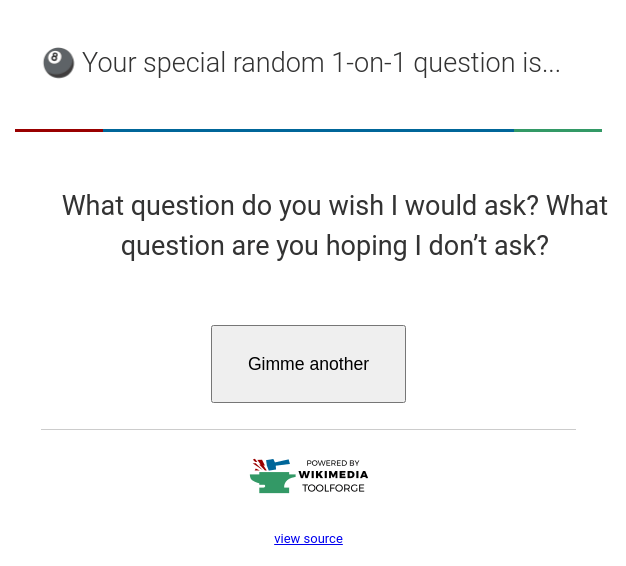It is unimaginably hard to […] stay conscious and alive in the adult world day in and day out.
– David Foster Wallace, This is Water
At the heart of my management philosophy lies a simple belief: people are working as hard as they can.
It’s a lazy assumption to assume people are lazy. Especially when burnout and overwork are so common.
And that’s why 1-on-1s are so crucial for engineering managers. Once a week, you get to reconnect with each person on your team.
But it’s all too easy to have another pointless meeting.
So, here is my kludged-together process to generate valuable 1-on-1s. I’ve honed it over time as a new(ish) engineering manager. I hope it will be helpful for both engineering managers and individual contributors.
💼 My basic agenda for 1-on-1s
I follow the GitLab handbook rule: No agenda; no attend…a.
When meetings lack an up-front agenda, I wonder whether anyone thought about the meeting at all. It’s a meeting smell. It warns me: this meeting is about to waste my time.
So, for my 1-on-1s, I use a simple agenda formula—Purpose, Outcome, Process (POP):
- Purpose – A once-per-week check-in between me and a direct report to ensure we’re OK. To provide feedback for each other and surface small problems (before they grow into big problems).
- Outcome – A solid understanding of our goals at work and an up-to-date picture of our current level of shared burnout.
- Process – My direct reports drive this one—it’s their meeting. But I fall back on a standard checklist if they come empty-handed.

I have a printable checklist for 1-on-1s. Everyone has access.
- “How’s it going?”/“What’s on your mind?” – this is often as far as I get in this meeting—and that’s wonderful.
- What was the highlight of your past week, work-related or not? I stole this from Clearbit’s Managers’ Handbook (which is an excellent resource). It reminds us: it’s a great big world—both inside and outside work—there’s fantastic stuff out there.
- Brag document – I cribbed this idea from Julia Evans—let’s update your brag document. A brag document is a running list of work you’ve completed. So, come promotion or review time, we have a convenient place to remind ourselves about your great work.
- Is there anyone you’d like to praise? – this question gives me feedback for someone on our team or another team’s manager. It’s a nice way to spread appreciation.
- Stop doing/keep doing – Feedback from me, feedback from you. I believe that success in management means no surprises—no wondering how I feel about your work. This small question keeps us both honest. Small feedback given often is usually all I need to provide folks. Quarterly review meetings, promotions, and performance improvement plans consist of the same feedback I share in these meetings.
📓 My note-taking and TODO system for 1-on-1s
I buy tons of cheap three-prong, twin-pocket file folders—every person on my team gets one.

Every workday, I review my calendar and print off a copy of my checklist for each of my 1-on-1s.
During the meeting, I take notes at the bottom of the checklist.
And after the meeting, those notes go into that person’s folder.
I highlight any TODOs I take during the meeting and add them to my handy dandy Ugmonk Analog.
🎒 All my 1-on-1 gear:
- Three-prong, twin-pocket file folders – each person on my team gets their own folder, which makes reviewing old notes quick and easy.
- Swingline three-hole punch – I’ve owned this since college, works great.
- Baronfig squire rollerball pen – I was gifted this pen for Christmas—it’s been weighty and satisfying.
- Kokuyo Mark+ 2-way highlighters – useful for ensuring any TODOs get done (or remembered, at least).
- Ugmonk Analog – an elegant alternative to a monitor covered in Post-Its.
- Brother laser printer – they no longer make the one I have. But whatever the ubiquitous $100 black-and-white laser printer du jour is is probably fine.
😬 To talk about hard topics, lean into awkward questions
If a 1-on-1 is never awkward—if the discussion is never challenging—you may be avoiding tough topics.
So, I built a thing that forces me into the danger zone.

I braved far too many “awesome 1-on-1 questions”-type listicles and distilled their wisdom into a small web tool. It gives me a linkable question to share during my 1-on-1s.
Toward the end of the meeting, I’ll often share a question from the list.
Some of the best ideas, initiatives, and experiments we’ve tried as a team come from these questions.
🚪 Watch out for doorknob comments
Doorknob comments are tantalizing tidbits dropped right as you’re about to end the meeting—when your hand’s on the doorknob to leave (or hovering above the “end call” button).
It’s easy to glide right over these comments unless you’re watching for them.
Parting volleys like, “I guess I’ll get back to it—if I could ever get my MR reviewed,” or “I sure wish we’d kill that project.”
These comments may seem like passing thoughts, but it’s possible your direct reports spent the whole meeting amping themselves up to say something important. And it’s your job in 1-on-1s to listen and learn.
It’d be a shame to lose these insights in the shuffle from one meeting to the next.
⚖️ 1-on-1 objections
Reasonable people have a lot of reasonable-sounding objections to 1-on-1s.
- “Everything’s fine. Do we need to talk every week?”
- “They’re too much of an interruption.”
- “They’re a waste of time.”
The solution here is to get curious. What could make this 1-on-1 better?
Of course, asking that question is a surefire way to make a 1-on-1 even more unbearable. So, instead, I turn to my favorite awkward question: what project are you most proud of?
If you listen to the answer, it often cuts right to what a person values.
If they’re proud of their big solo rewrite, maybe they want more independence and challenge. If they’re proud of the small tweak they made that saved 100s of hours of toil, maybe they’re searching for more impact.
Of course, you have to be genuinely curious—you have to dig into these answers to learn anything.
And that’s the only secret of successful 1-on-1s: if you want your direct report to care, you have to care.
If you want to have interesting 1-on-1s: get interested.